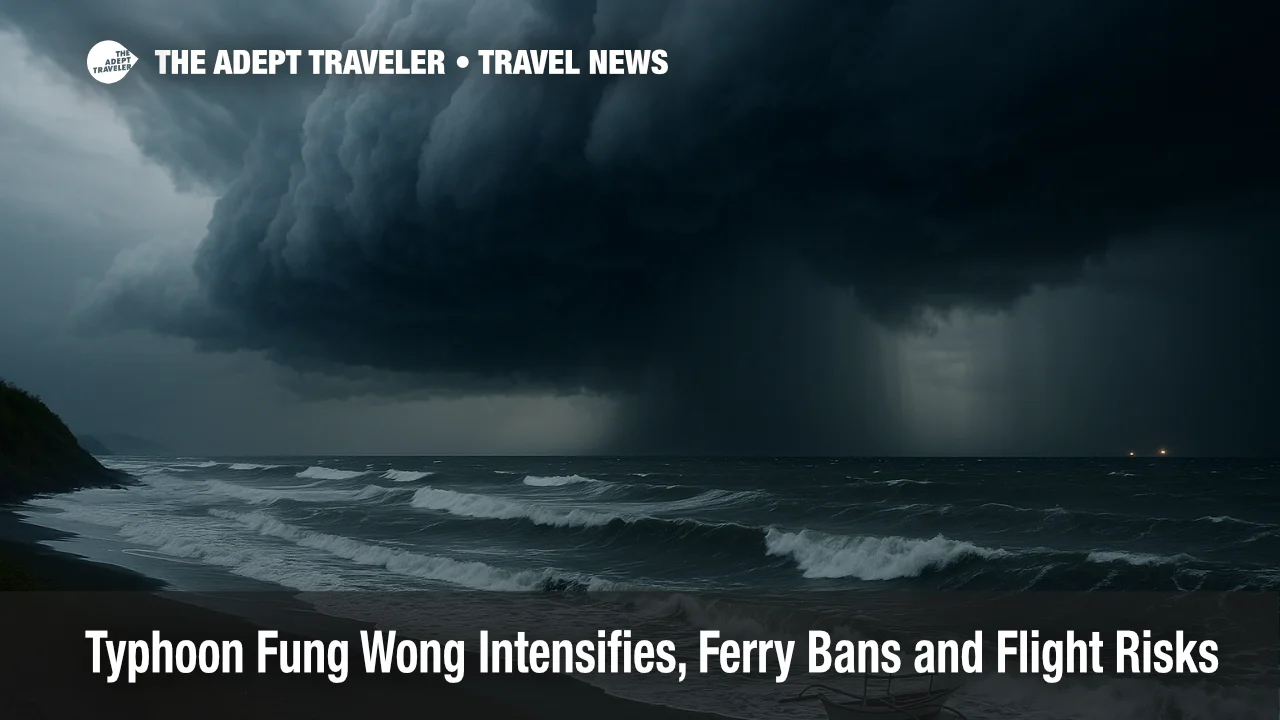Typhoon Fung Wong Intensifies, Ferry Bans and Flight Risks

Key points
- PAGASA raises Tropical Cyclone Wind Signals over parts of Luzon and the Visayas as Fung Wong intensifies
- Philippine Coast Guard suspends selected ferry routes with additional corridors on watch
- Airlines cancel or adjust flights for November 9 to 10 and advise passengers to check status
- Travelers transiting Manila and Clark should add buffer time and monitor advisories
Impact
- Airports
- Expect rolling delays, schedule changes, and occasional ground stops at Manila and Clark during peak bands of rain and wind
- Ferries
- Multiple corridors suspended or restricted by the Coast Guard as seas build, check specific port authorities before travel
- Airlines And Waivers
- Philippine Airlines and Cebu Pacific list cancellations and rebooking guidance, verify eligibility before heading to the airport
- Driving And Transfers
- Localized flooding and traffic are likely near coastal and low lying roads, allow extra time for airport and port transfers
- What To Do
- Confirm flight status in app, move to earlier departures when offered, and keep hotel and tour plans flexible through the weather window
Typhoon Fung Wong, locally Uwan, continued to intensify on November 8, 2025, with PAGASA hoisting Tropical Cyclone Wind Signals across parts of Luzon and the Visayas. Authorities warned of violent winds, heavy rain, and life threatening storm surge, and local governments began preemptive closures and evacuations in exposed provinces. Marine travel on several corridors has been suspended, and airlines issued rolling cancellations for November 9 to 10, urging passengers to check status before leaving for the airport.
PAGASA signals and track
PAGASA's evening bulletins placed areas of Bicol, Catanduanes, Samar, and portions of Northern Luzon under higher Tropical Cyclone Wind Signals as bands intensified around the core. By late evening, updates noted continued strengthening and the potential to reach super typhoon intensity, with surge heights up to five meters along vulnerable east facing coasts. The storm's broad circulation means rain and gusty conditions far from the center as it approaches and then tracks northward past Luzon.
Marine suspensions
The Philippine Coast Guard ordered targeted suspensions of sea voyages as seas roughened, including parts of Bohol, Western Leyte, and Dinagat, with additional local bans posted as conditions worsen. Travelers should expect same day changes as stations update at short notice, and should verify with the specific port office or operator before departing for the terminal.
Airline moves and airport operations
Philippine Airlines and Cebu Pacific have published cancellations and advisories covering November 9 to 10, including domestic sectors most exposed to crosswinds and low visibility. Manila Ninoy Aquino International Airport and Clark International Airport remain open with heightened readiness, but operators warn that delays, holds, or diversions may occur as squalls pass over the terminals. The Civil Aviation Authority advised travelers to allow extra time and to follow airline notices closely.
Background
Tropical Cyclone Wind Signals are PAGASA's tiered alerts that reflect expected wind strength and timing. Higher signals imply stronger winds arriving sooner, which can trigger automatic maritime suspensions and school or office closures. The Philippine Coast Guard halts or restricts voyages on affected routes when gale conditions or surge risks are forecast. Airlines then adjust rotations, swap aircraft, or pre cancel flights to avoid stranding aircraft and crews in the wrong places as airfields cycle through weather bands.
Practical guidance
If you are booked through Manila or Clark, build a larger connection cushion, pre download your airline app, and enable push alerts. Where carriers are offering free changes, move to earlier flights that operate before peak weather, or shift to the day after the worst conditions pass. For island hops, assume ferries on exposed east coast routes may pause with little notice, and have a same day land based alternative ready. Keep rides flexible for road transfers, since localized flooding can add travel time to and from airport terminals.
Final thoughts
Typhoon Fung Wong is strengthening and expanding its footprint, and the combination of wind signals, ferry suspensions, and airline cancellations points to a dynamic 48 hour window for travelers. Stay tightly aligned to PAGASA updates and first party airline and port advisories, and keep plans flexible until conditions stabilize.
Sources
- Tropical Cyclone Bulletin, Typhoon Uwan (Fung Wong), Nov 8, 2025
- Philippines Warns of Deadly Storm Surges as Typhoon Fung Wong Nears
- Typhoon Uwan Live Updates, Nov 8, 2025
- Flight Cancellations Due to Typhoon Uwan, Philippine Airlines
- Cancelled Flights Due to Severe Tropical Storm Fung Wong, Cebu Pacific
- Airlines Cancel Nov 9 to 10 Flights
- CAAP Advisory for Approaching Typhoon
- PCG Suspends Bohol Sea Trips as Uwan Spawns Rough Seas
